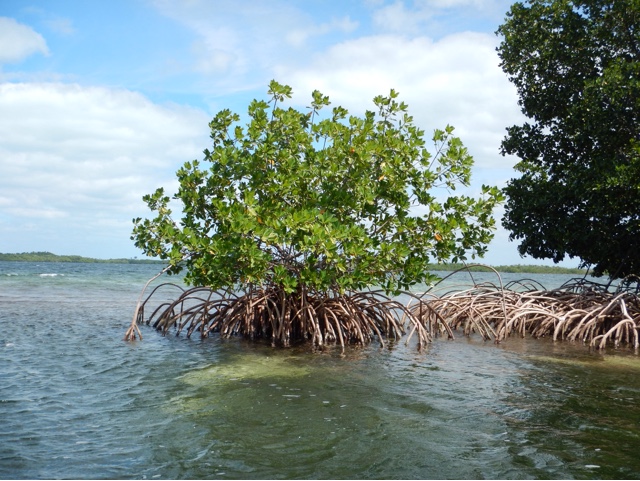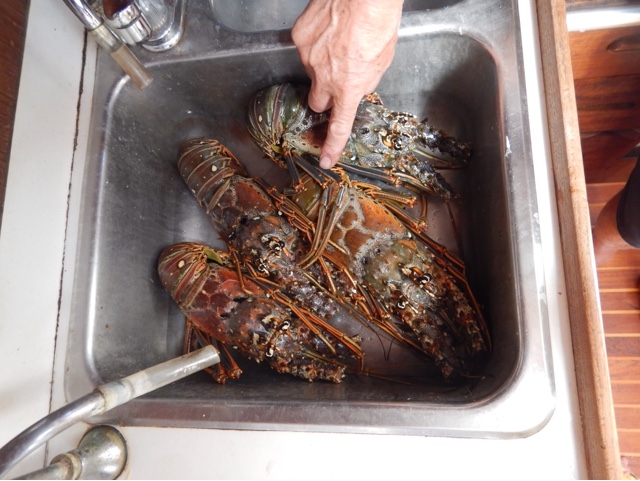We left civilization and some cruising buddies once we left Cayo Levisa. We have been taking our time and doing short hops and riding the easterlies, west down the north shore of Cuba. Our anchorages have consisted of Cayos or Keys, small mostly mangrove islands that are inside the reef that separates Cuba from the Straits of Florida. The cruisng guide we have is excellent with very specific routes to get in and out of the anchorages so there have been very few stressful moments since we left Marina Hemigway!! For the most part the sky has been clear enabling us to see and avoid the reefs and sandbars we have to weave through to get to the anchorages. At Cayo Innes de Soto we stayed for a few days while a blustery (30 knot) wind blew itself out. Each day we took a dinghy ride through the mangrove maze. At one spot we saw the remains of some sort of fishing weir. It had been built across the channel. I imagine at some point it was very effective in catching any fish that had the misfortune of swimming through the spot.
One day after we had set anchor we spied a small fishing boat chugging noisily towards us. We negotiated a price and they left with 4 fewer lobsters and 2 fewer fish than they had arrived with. There was a father, his two sons and a buddy on board, I asked if I could take a picture but was refused. The Captain indicated that they were not supposed to be consorting with us. We managed to figure out a few things he said but his Spanish was very different than we have encountered before and we had trouble understanding him.
We have been on the go for almost two weeks and we have no fresh fruit or vegetables on board. We thought we might be able to procure some in the town of La Fe, a very small place, which seems to be dedicated to fishing. Once we anchored the Gaurda called us on the radio and spouted increasingly frustrated demands at us over the radio. We tried as best we could to answer his questions but did not succeed. We went ashore in the dinghy, the book said we could, and were met two yards off shore by the head guy. He looked at our papers and then very patiently explained that international boats could not go here, there were no tourist accomodations, ( this was the Cuba we wanted to see) and we would not be allowed to come ashore. I told him we had no fruits and vegetables and that we wanted some very badly, no luck! To give him credit he did allow us to spend the night at anchor but demanded to know when we were going to leave and what time did we expect to get to our next anchorage. HUMFF!!
Barry was very disappointed we could not explore the town, I am sad there are not fresh veggies for supper and the town's school missed out on some new school supplies. Oh well, we amused ourselves by watching the antics of the local populace. A powered fishing boat came by, they have very old hand cranked diesel engines in their boats, somewhat similar to the boat below, but most of them have a cabin with a wooden roof built that offers some protection from the wind and waves.
He was pulling a single fisherman in a dory which is an open fishing boat that they row around with great long wooden oars. There was a problem with the engine, so they threw out the anchor, then a second fisherman jumped in the engineless boat and proceeded to try and tow the larger boat to port by man power alone. Things were not going well, then the third fisherman still aboard the bigger boat fiddled with the transmission and the powered vessel took off dragging the hapless smaller boat, what fun. They managed to get disentangled and all made it ashore safely. This is another method of fishing, he is just in an inner tube and he has on flippers to propel himself around the anchorage. We saw three of four different fellows out and they all stayed in the protected area not far from the wharf. Then the fellow who sternly told us we were not allowed ashore decided that he needed to dig a trench for boats to come up to the Gaurda post. A biggish tractor ground it's way through the shallows and a harrow on the back was dragged around a bit. Then the predictable happened and it got stuck! It looked pretty funny at a 30 degree angle, with it's huge back tire spinning in the mud. Well, bricks and pieces of cement were hauled out to it to try and give it some purchase, a large slab of wood was dragged out, at least an hour was spent working away at this. Finally anothe tractor showed up and after a bit of maneuvering it managed to pull the first one out. I am not sure whether the goal of the exercise was ever accomplished but we enjoyed the spectacle.
Sailing Info.
We are using the "Cruisng Guide to Cuba" written by Capt. Cheryl Barr, Volume 1, Varadero to Trinidad, published by Yacht Pilot in Nova Scotia. It has lots of great information, with way points to help you transit narrow passes and lots of information on what is available in the small towns covered by the book, as well as the flora and fauna in the area. We have heard the Nigel Calder's book is very good as well.
Cayo Innes de Soto 22*47.8' N X 083*46.9' W
Anchored in 4m of water, good holding in clay and mud.
Protection form north and east, open to the west.
No services
Punta Alonso De Rojas 22*36.9' N X 084*07.6' W
Anchored in 4m of water, good holding once anchor set, it took three tries to set, lots of grass
Protection from north and east and south east, open to the west
Fishermen stopped by and we bought lobster and fish, no services
Cayo Rapado Grande 22*29.4' N X 084*19.7' W
Anchored in 3.5m of water up in the mangroves, anchor caught first try, good holding
Great protection only open to the west
No services
All way points from cruising guide are spot on. Very helpful.
Ensenada de Anita 22*11.9' N X 084*25.3' W
Anchored in 3.5m of water, very good holding
Good protection from east and south, open to the southwest, protected but not well from north
No services, you need to have good light and use eyeball navigation to get in this anchorage
La Fe 22*02.3' N X 084*16.7' W
Anchored in 4m. of water, good holding
Good all around protection
Services not available. We were not allowed to go ashore, they let us anchor for the night.































